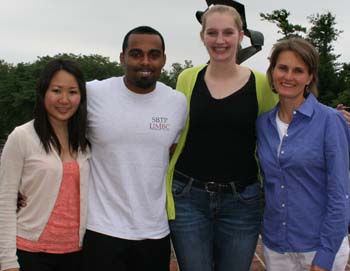
Laura Furge, the Roger F. and Harriet G. Varney Professor of Chemistry at Kalamazoo College, is the senior and corresponding author of an important scientific paper that includes three Kalamazoo College student co-authors: Amanda Bolles ’14, Rina Fujiwara ’15, and Erran Briggs ’14. The paper is titled “Mechanism-based Inactivation of Human Cytochrome P450 3A4 by Two Piperazine-containing Compounds” and appears in Drug Metabolism and Disposition, a highly regarded, high impact international journal published by the American Society for Pharmacology and Experimental Therapeutics. The research the paper describes, which was conducted in the Furge Lab on K’s campus, contributes the understanding of how some drugs “apply the brakes to” the activity of an enzyme–in this particular case, an enzyme important to the metabolism (or processing) of about half of all medicines! What are the human implications of the work? “Many individuals take multiple medicines each day,” said Furge. “Multiple-drug regimens can lead to unwanted side effects, including drug-induced inhibition of the very enzymes responsible for the metabolism and clearance of other co-administered drugs.” In fact, side effects from drug interactions of polypharmacy therapy are the number one cause of hospitalization in the U.S. “This paper adds in understanding of how certain classes of drugs may cause this type of unfavorable medical event,” said Furge. “New insights will hopefully lead to better prevention in the future.”
The paper includes 13 figures and tables. Furge noted that Bolles, Fujiwara, and Briggs performed all the experiments that lead to those figures, and “all the work was done on the campus at Kalamazoo College. We had all the equipment here needed to complete these studies, and we have already started full swing on another set of experiments for a future publication.” The students have presented parts of the preliminary data at national meetings in the past year, and the research forms of basis of the Senior Individualized Projects for Bolles and Fujiwara.
Such research, and the extraordinary educational opportunities it provides for K students, requires the cooperation, coordination, and collaboration of many funding sources. “This is so important,” Furge stressed. The Richard Cook Fellowship and the Alan and Elaine Hutchcroft Fund (endowments created and supported by alumni gifts) paid for the summer stipends of Fujiwara and Bolles, respectively. The mass spectrometer essential to the experiments was paid for in part by the Hutchcroft Fund and a grant from the Howard Hughes Medical Institute. The research also was funded by grants Furge secured from the National Institutes of Health.
“Drug Metabolism and Disposition is an international journal with a high impact factor,” added Furge. Impact factors measure how frequently manuscripts in a journal are referenced by other authors.









